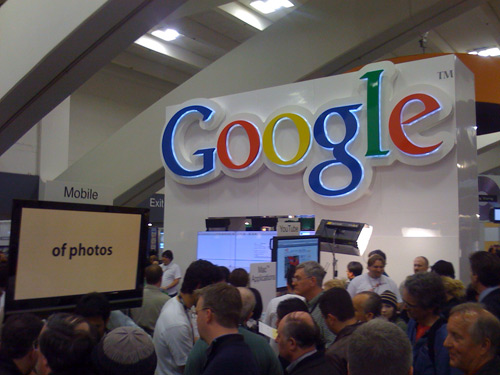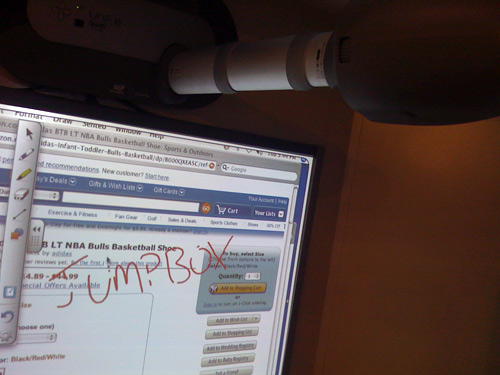I started reading this one on the beach a few months back and just finished it today. Any book that
a) has a conversation with the Dalai Lama in it and
b) claims that happiness is an art that can be mastered
has my attention. I found this to be an extremely slow read though- I would pick it up and casually read a chapter here and there but would never fully engage enough to plow through it in a single setting. I think it was mostly the mildness of the message- if it were a big, spicy meal you could eat all at once but you can only handle a couple spoonfuls of babyfood in a sitting. Of all the ideas put forth in the book, the most interesting realization I had was this:
Art of Happiness:Life::Emyth:Business
The Dalai Lama advocates a similar methodology for advancing happiness in one’s life that Michael Gerber does for advancing one’s business with the main premise of Emyth (ie. work on your business and not just in your business). The book is a recap of private conversations with the DL while he was in AZ circa 1993 giving public talks. The interviewer is an MD with a background in psychiatry and neurology and adds in his own commentary. While there were no extraordinary “light bulb moments” from reading the interviews, I did find a couple ideas interesting:
 We don’t all have to eat the same religious dish or even dine at the same restaurant. The DL has this meta view on religion that if it helps people be better people and more spiritual, then it’s a good thing (but only insofar as it accomplishes that). He doesn’t propose that Buddhism is the right religion. He instead equates choice of religion to the diversity of food tastes- the world would be a boring place if we all ate the same thing at the same restaurant. Having been raised Catholic for 15yrs of life, I had some seriously warped views of religion that took years to shed. The DL not only advocates religious tolerance but religious exploration to expand one’s spiritual palette.
We don’t all have to eat the same religious dish or even dine at the same restaurant. The DL has this meta view on religion that if it helps people be better people and more spiritual, then it’s a good thing (but only insofar as it accomplishes that). He doesn’t propose that Buddhism is the right religion. He instead equates choice of religion to the diversity of food tastes- the world would be a boring place if we all ate the same thing at the same restaurant. Having been raised Catholic for 15yrs of life, I had some seriously warped views of religion that took years to shed. The DL not only advocates religious tolerance but religious exploration to expand one’s spiritual palette.
 Cultivating compassion as a weapon against anger The DL believes that by holding a compassionate state of mind through meditation that this feeling can be grown over time and that the only true way to dispel negative emotions like anger, jealousy, conceit, etc is by supplanting them with other benign ones. Western culture espouses the idea of “venting” anger through socially acceptable means. The DL would argue that this actually has the adverse effect of habituating the individual to the negative emotions and embeds them more deeply. His proposed solution is to displace rather than vent.
Cultivating compassion as a weapon against anger The DL believes that by holding a compassionate state of mind through meditation that this feeling can be grown over time and that the only true way to dispel negative emotions like anger, jealousy, conceit, etc is by supplanting them with other benign ones. Western culture espouses the idea of “venting” anger through socially acceptable means. The DL would argue that this actually has the adverse effect of habituating the individual to the negative emotions and embeds them more deeply. His proposed solution is to displace rather than vent.
 The way to transform suffering DL and enlightened individuals are able to shift perspective and treat suffering and adversity as an opportunity. You become thankful for your enemies and obstacles in the way that you are thankful for the weights in the gym: you may hate them while you’re lifting but you appreciate the benefits they yield and their role in stretching and strengthening your body. If life were purely a cozy cocoon in zero gravity with zero adversity we’d all be mushy objects devoid of any strengths and hard edges. Adversity provides the kiln that enables us to forge these strengths.
The way to transform suffering DL and enlightened individuals are able to shift perspective and treat suffering and adversity as an opportunity. You become thankful for your enemies and obstacles in the way that you are thankful for the weights in the gym: you may hate them while you’re lifting but you appreciate the benefits they yield and their role in stretching and strengthening your body. If life were purely a cozy cocoon in zero gravity with zero adversity we’d all be mushy objects devoid of any strengths and hard edges. Adversity provides the kiln that enables us to forge these strengths.
 His “Green Mile” exercise He talks extensively about a Mahayana visualization practice called Tong-Len in which the practitioner imagines taking on all the world’s suffering and “laundering” it. It reminded me a lot of that movie Green Mile where the main character would inhale the illnesses of others. At the core of what DL proposes is this idea of establishing greater empathy and connection with others. By undertaking the “Green Mile” exercise we envision inhaling the suffering of others to spare them from it and in so doing help dissolve cultural barriers and commiserate with others in pain. These bridges of compassion across cultural boundaries hold the most promise for establishing a sustainable world peace.
His “Green Mile” exercise He talks extensively about a Mahayana visualization practice called Tong-Len in which the practitioner imagines taking on all the world’s suffering and “laundering” it. It reminded me a lot of that movie Green Mile where the main character would inhale the illnesses of others. At the core of what DL proposes is this idea of establishing greater empathy and connection with others. By undertaking the “Green Mile” exercise we envision inhaling the suffering of others to spare them from it and in so doing help dissolve cultural barriers and commiserate with others in pain. These bridges of compassion across cultural boundaries hold the most promise for establishing a sustainable world peace.
 Guilt- a completely foreign concept to Eastern thought DL believes that our natural mental state is one of peace and clarity and that all the negative stuff are just these artificial blemishes that mar an otherwise pure form. This is a very different proposal from the Catholic notion of original sin and guilt. Self-hatred and guilt just aren’t concepts that Buddhists understand, it would be like trying to explain trees or sand to an Eskimo. Apparently the DL is aware of these concepts but totally impervious, they pass through him and seem strange.
Guilt- a completely foreign concept to Eastern thought DL believes that our natural mental state is one of peace and clarity and that all the negative stuff are just these artificial blemishes that mar an otherwise pure form. This is a very different proposal from the Catholic notion of original sin and guilt. Self-hatred and guilt just aren’t concepts that Buddhists understand, it would be like trying to explain trees or sand to an Eskimo. Apparently the DL is aware of these concepts but totally impervious, they pass through him and seem strange.
 How to diffuse anxiety I liked his method for dismantling anxiety. Think of it like this- scenario:
How to diffuse anxiety I liked his method for dismantling anxiety. Think of it like this- scenario:
a) the thing you’re worrying about does have a possible solution and therefore any energy you expend on worrying is time stolen from working towards that solution. so don’t worry.
b) there is no solution for the problem you’re worrying about (death & taxes) and therefore there is nothing that can be accomplished by worrying. so don’t worry.
 His meditation on absence of thought This was actually one of the more interesting things I found in the book. Towards the very end he’s leading a room full of 1500 people through this mental exercise in which thoughts are banished from the mind until a state of total mental clarity exists and your mind is perfectly calm. What was interesting is that I had invented a technique of my own which is similar to this exercise for the times I have trouble falling asleep. This sounds weird but I’m able to hold this recursive thought that displaces the others and eventually “swallows itself.” My mind is going full throttle most of the time and this trick is the only thing that lets me fall sleep sometimes. It’s difficult to verbalize the technique but it’s something like taking this sentence:
His meditation on absence of thought This was actually one of the more interesting things I found in the book. Towards the very end he’s leading a room full of 1500 people through this mental exercise in which thoughts are banished from the mind until a state of total mental clarity exists and your mind is perfectly calm. What was interesting is that I had invented a technique of my own which is similar to this exercise for the times I have trouble falling asleep. This sounds weird but I’m able to hold this recursive thought that displaces the others and eventually “swallows itself.” My mind is going full throttle most of the time and this trick is the only thing that lets me fall sleep sometimes. It’s difficult to verbalize the technique but it’s something like taking this sentence:
What’s it like to think without thought.
And gradually having it eat itself so it becomes:
What’s it like to think without thought.
What’s it like to think without.
What’s it like to think.
What’s it like to.
What’s it like.
What’s it.
What.
.
I know that sounds weird (and probably counting sheep works just as well for most people) but the exercise he conducted reminded me a lot of this. It’s cool to independently arrive at a tactic that the DL uses himself.
All in all a decent book- a bit slow though. If some of these concepts seem painfully obvious, I wouldn’t disagree, but it’s always nice to have things summed up well in one place. The subtitle of this book is “A Handbook for Living” – I wish we would have studied this book in school growing up rather than the 10years of CCD education (ideas that have taken twice that long to unravel). If you like The Art of Happiness, here are some other titles that have a similar flavor and I found them to be more engaging:
Seven Laws of Spiritual Success
Four Agreements
The Alchemist
UPDATE: just noticed the random timing of this post coinciding with the Davos Forum. Clearly the DL’s answer to that question is the idea of cultivating compassion and empathy through these exercises. I would say in more practical terms of actionable things that can be implemented tomorrow- achieving mainstream awareness of microfinance sites like Kiva.org and incenting people with 1-to-1 tax breaks on all loans would be a huge step in the right direction. Entrepreneurship is the way forward for so many reasons and these micro-lending sites are proving to be hugely effective because there’s more dignity in a loan and when it’s paid back, those funds can be re-loaned. I just got an email an hour ago that a year ago via Kiva has been paid in full and the funds are available to be loaned to another applicant. This stuff does work.
 WHAT: the Adium/Gaim/Trilian of social networks
WHAT: the Adium/Gaim/Trilian of social networks
 We don’t all have to eat the same religious dish or even dine at the same restaurant. The DL has this meta view on religion that if it helps people be better people and more spiritual, then it’s a good thing (but only insofar as it accomplishes that). He doesn’t propose that Buddhism is the right religion. He instead equates choice of religion to the diversity of food tastes- the world would be a boring place if we all ate the same thing at the same restaurant. Having been raised Catholic for 15yrs of life, I had some seriously warped views of religion that took years to shed. The DL not only advocates religious tolerance but religious exploration to expand one’s spiritual palette.
We don’t all have to eat the same religious dish or even dine at the same restaurant. The DL has this meta view on religion that if it helps people be better people and more spiritual, then it’s a good thing (but only insofar as it accomplishes that). He doesn’t propose that Buddhism is the right religion. He instead equates choice of religion to the diversity of food tastes- the world would be a boring place if we all ate the same thing at the same restaurant. Having been raised Catholic for 15yrs of life, I had some seriously warped views of religion that took years to shed. The DL not only advocates religious tolerance but religious exploration to expand one’s spiritual palette.

 They certainly have demonstrated they know how generate buzz. Aside from having a stellar UI in their products they had amazing visual presence at the show. With these cinematic and creative displays you have everyone with a camera posing for pics with Apple logos in the background and then talking about how incredible the setup was (me case in point right now). As far as product launches, nobody needs the new Mac Air but the way they present it sure makes you want one.
They certainly have demonstrated they know how generate buzz. Aside from having a stellar UI in their products they had amazing visual presence at the show. With these cinematic and creative displays you have everyone with a camera posing for pics with Apple logos in the background and then talking about how incredible the setup was (me case in point right now). As far as product launches, nobody needs the new Mac Air but the way they present it sure makes you want one. 

 The other one that really grabbed me was
The other one that really grabbed me was 







